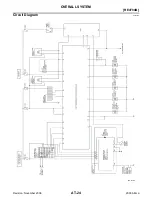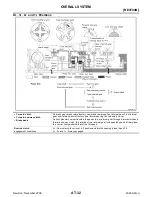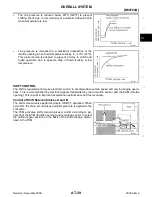
OVERALL SYSTEM
AT-37
[RE4F04B]
D
E
F
G
H
I
J
K
L
M
A
B
AT
Revision: November 2006
2006 Altima
TCM FUNCTION
The function of the TCM is to:
●
Receive input signals sent from various switches and sensors.
●
Determine required line pressure, shifting point, lock-up operation, and engine brake operation.
●
Send required output signals to the respective solenoids.
INPUT/OUTPUT SIGNAL OF TCM
Sensors and solenoid valves
Function
Input
Park/neutral position (PNP) switch
Detects select lever position and sends a signal to TCM.
Accelerator pedal position (APP) signal
Detects throttle valve position and sends a signal to TCM. (CAN communi-
cation)
Engine speed signal
Receives signal from ECM and controls lock-up control solenoid valve.
A/T fluid temperature sensor
Detects transaxle fluid temperature and sends a signal to TCM.
Revolution sensor
Detects output shaft rpm and sends a signal to TCM.
Vehicle speed sensor
Used as an auxiliary vehicle speed sensor. Sends a signal when revolution
sensor (installed on transaxle) malfunctions.
3 position switch
Sends a signal, which prohibits a shift to D
4
(overdrive) position, to the
TCM.
ASCD control signal
Sends the cruise signal and D
4
(overdrive) cancellation signal from ASCD
control unit to TCM.
Stop lamp switch
Send the lock-up release signal to the TCM at time of D
4
(lock-up).
CAN communication
In CAN communication, control units are connected to 2 communication
lines (CAN H line, CAN L line) allowing a high rate of information transaxle
with less wiring.
Output
Shift solenoid valve A/B
Selects shifting point suited to driving conditions in relation to a signal sent
from TCM.
Line pressure solenoid valve
Regulates (or decreases) line pressure suited to driving conditions in rela-
tion to a signal sent from TCM.
Torque converter clutch solenoid valve
Regulates (or decreases) lock-up pressure suited to driving conditions in
relation to a signal sent from TCM.
Overrun clutch solenoid valve
Controls an “engine brake” effect suited to driving conditions in relation to a
signal sent from TCM.
A/T check (position) indicator lamp
Shows TCM faults, when A/T control components malfunction.
CAN communication
In CAN communication, control units are connected to 2 communication
lines (CAN H line, CAN L line) allowing a high rate of information transaxle
with less wiring.
















































